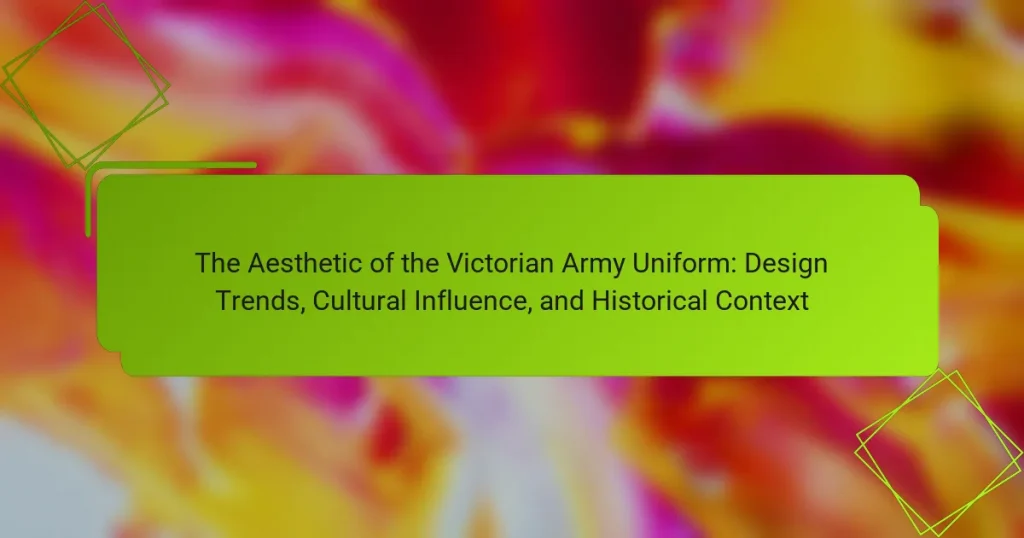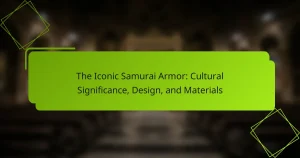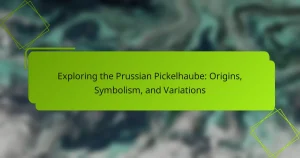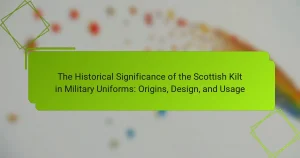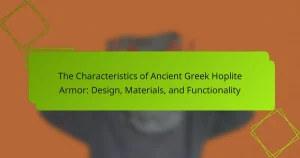The Victorian Army uniform is characterized by its elaborate design and rich symbolism, reflecting both military tradition and Victorian fashion trends. Key features include bright colors like red and blue, intricate embellishments such as gold braid and epaulettes, and precise tailoring that enhances the wearer’s stature. The materials used, including luxurious wool, cotton, and silk, highlight the dual purpose of these uniforms for function and ceremonial occasions. This article explores the aesthetic aspects of the Victorian Army uniform, discussing its design trends, cultural influences, and the historical context that shaped its development, ultimately illustrating how these uniforms embodied national pride and the empire’s global presence.
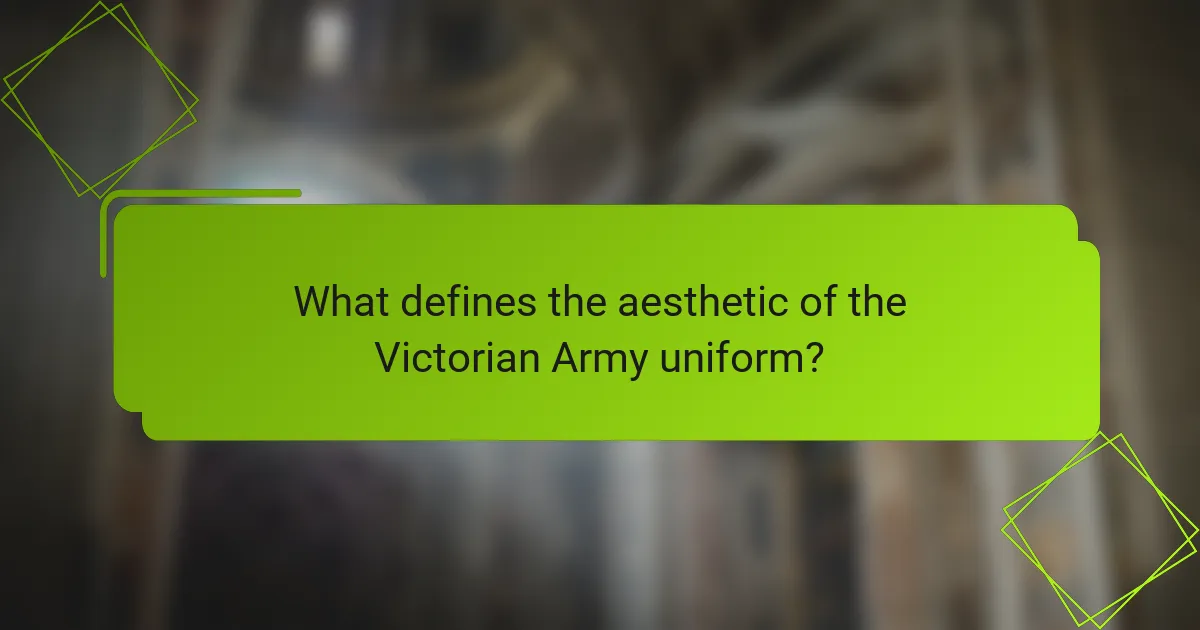
What defines the aesthetic of the Victorian Army uniform?
The aesthetic of the Victorian Army uniform is defined by its elaborate design and rich symbolism. Uniforms featured bright colors, such as red and blue, which conveyed authority and tradition. The use of intricate embellishments, including gold braid and epaulettes, emphasized rank and distinction. Tailoring was precise, creating a fitted silhouette that enhanced the wearer’s stature. Fabrics were often luxurious, incorporating wool, cotton, and silk. The style was influenced by military traditions and Victorian fashion trends. Historical context shows that these uniforms were designed for both function and ceremonial purposes. The Victorian Army uniform reflected national pride and the empire’s global presence.
How did design trends evolve during the Victorian era?
Design trends during the Victorian era evolved significantly, reflecting the cultural and technological changes of the time. The era, spanning from 1837 to 1901, saw a shift from the ornate styles of the earlier periods to more eclectic and functional designs. The introduction of new materials and manufacturing techniques influenced these changes. Industrialization allowed for mass production, which made fashionable items more accessible to the middle class.
Victorian design often incorporated historical styles, leading to a revival of Gothic, Romanesque, and Renaissance elements. This eclecticism was evident in architecture, furniture, and fashion. The Arts and Crafts movement emerged in response to industrialization, emphasizing craftsmanship and simplicity.
In military uniforms, the Victorian era saw the adoption of bold colors and intricate embellishments, reflecting national pride and identity. The use of insignia and medals became more prominent, symbolizing rank and achievements. Overall, design trends during this period were characterized by a blend of tradition and innovation, shaped by societal values and advancements.
What were the key characteristics of Victorian Army uniforms?
Victorian Army uniforms were characterized by their distinctive colors, intricate designs, and functional elements. The uniforms often featured bright colors, such as red for infantry and blue for artillery. Gold or silver embellishments were common, adding a decorative aspect to the attire. The use of epaulettes and badges indicated rank and unit affiliation. Heavy wool fabrics provided durability and warmth. Trousers were typically worn with a tunic, creating a formal appearance. Headgear included shakos and helmets, which were designed for both protection and display. These characteristics reflected the military hierarchy and the era’s aesthetic values.
How did materials and colors influence the uniform design?
Materials and colors significantly influenced the design of Victorian army uniforms. The use of wool was prevalent due to its durability and ability to provide warmth. Additionally, cotton was often utilized for summer uniforms, ensuring comfort in warmer climates. The choice of colors was also crucial; red became a symbolic color for British regiments, representing bravery and valor. Other colors, such as blue and green, were chosen for their association with specific regiments and their camouflage properties. The combination of materials and colors not only served practical purposes but also conveyed rank and unit identity. Historical records indicate that the vibrant colors helped maintain visibility on the battlefield while promoting a sense of unity among troops.
What cultural influences shaped the Victorian Army uniform?
The Victorian Army uniform was shaped by various cultural influences, including social hierarchy and military tradition. The design reflected the British Empire’s status and values during the 19th century. Bright colors and ornate embellishments symbolized rank and unit affiliation. The use of specific fabrics, like wool and cotton, was influenced by practicality and climate. Military uniforms also drew inspiration from ceremonial attire, reflecting a blend of functionality and pageantry. The adoption of foreign styles, such as the French and Prussian influences, further diversified the uniform’s design. Additionally, public sentiment and nationalism played a significant role in shaping the aesthetics of the uniform. The Victorian Army uniform thus became a representation of both military identity and cultural pride.
How did social status impact uniform design and symbolism?
Social status significantly influenced uniform design and symbolism in the Victorian Army. Higher ranks featured elaborate designs and distinctive insignia. These elements visually communicated authority and prestige. For example, officers wore more ornate uniforms compared to enlisted soldiers. The use of specific colors and materials also reflected social hierarchy. Rich fabrics indicated higher social standing, while simpler designs were for lower ranks. Historical records show that uniforms evolved to represent class distinctions. This differentiation was crucial for maintaining order and discipline within the ranks. Thus, social status shaped the aesthetic and functional aspects of military uniforms during the Victorian era.
What role did the British Empire play in uniform aesthetics?
The British Empire significantly influenced uniform aesthetics through its military design choices. The Empire’s vast reach allowed for the integration of diverse cultural elements into military uniforms. This blending resulted in distinctive styles that reflected both British traditions and local influences. For example, the iconic red coat of the British Army became a symbol of imperial power. Additionally, the use of elaborate embellishments and insignia showcased rank and affiliation. The Empire’s emphasis on discipline and order also shaped uniform designs, promoting a sense of unity among troops. Historical events, such as the Crimean War, further impacted uniform evolution, leading to practical adaptations. Overall, the British Empire’s role in uniform aesthetics was marked by a combination of tradition, cultural exchange, and functional considerations.
What historical context is essential to understanding the Victorian Army uniform?
The historical context essential to understanding the Victorian Army uniform includes the British Empire’s expansion during the 19th century. This period saw the army’s role in colonial conflicts and the need for a distinct identity. The uniform reflected military hierarchy and discipline, often featuring bright colors and elaborate designs. The Crimean War (1853-1856) influenced practical changes in uniform design for better functionality. Industrial advancements allowed for mass production of uniforms, standardizing styles across the army. Social class distinctions were also evident in uniform variations, emphasizing rank and status. The Victorian era’s emphasis on aesthetics further shaped the uniform’s visual appeal and cultural significance.
How did military conflicts influence uniform design during the Victorian era?
Military conflicts significantly influenced uniform design during the Victorian era. The Crimean War (1853-1856) led to practical changes in military attire. Officers adopted more functional and comfortable designs for better mobility. Additionally, the need for camouflage emerged from experiences in various terrains. The introduction of khaki during the late Victorian period exemplified this shift. The Indian Rebellion of 1857 also prompted changes, as uniforms were adapted for tropical climates. Furthermore, advancements in textile technology allowed for more durable and varied materials. These adaptations reflected both the realities of warfare and the evolving aesthetic preferences of the time.
What were the technological advancements affecting uniform production?
The technological advancements affecting uniform production included the introduction of sewing machines, synthetic dyes, and improved textile manufacturing processes. Sewing machines revolutionized garment construction by significantly increasing production speed and efficiency. Synthetic dyes, developed in the mid-19th century, allowed for a wider range of vibrant colors in uniform fabrics. Enhanced textile manufacturing techniques, such as the use of looms, improved fabric quality and durability. These advancements collectively transformed the design and production of Victorian army uniforms, enabling more intricate designs and faster production timelines.
How did the Victorian Army uniform reflect societal values?
The Victorian Army uniform reflected societal values by embodying ideals of discipline, honor, and national pride. The design emphasized a structured appearance, showcasing the importance of military order. Bright colors and elaborate decorations symbolized the glory of the British Empire. Uniforms were often tailored to convey status and professionalism. This attention to detail mirrored the Victorian emphasis on propriety and respectability. Additionally, the use of specific insignia represented loyalty and service. The uniform’s evolution paralleled changing societal perceptions of military roles. Overall, the Victorian Army uniform served as a visual representation of the prevailing values of the time.
What impact did the Victorian Army uniform have on modern military attire?
The Victorian Army uniform significantly influenced modern military attire. Its design emphasized functionality and discipline. The use of tailored cuts and structured forms set a precedent for contemporary uniforms. Bright colors and distinctive insignia became common for identification purposes. The Victorian era also introduced practical elements like pockets and epaulettes. These features have been adapted in various modern military outfits. The emphasis on ceremonial aspects remains evident in today’s formal military dress. Overall, the Victorian uniform established foundational principles still relevant in current military fashion.
What are some practical tips for studying Victorian Army uniforms?
Examine primary sources such as military records and photographs to study Victorian Army uniforms. Analyze historical documents for details on uniform regulations and changes over time. Visit museums with military exhibits for firsthand observation of uniforms. Utilize academic books focused on Victorian military history for in-depth information. Engage with online databases that specialize in historical military attire. Join forums or groups dedicated to military history for discussion and insights. Attend reenactments or historical events to see uniforms in context. Document findings to create a personal reference for further study.
The main entity of the article is the Victorian Army uniform, which is characterized by its elaborate design, vibrant colors, and rich symbolism. The article explores the evolution of design trends during the Victorian era, highlighting the influence of cultural factors, social hierarchy, and military conflicts on uniform aesthetics. Key characteristics, such as materials and colors, are examined in relation to their practical and symbolic significance. Additionally, the article discusses the impact of technological advancements on uniform production and the uniform’s lasting influence on modern military attire. Overall, it provides a comprehensive overview of the historical context and societal values reflected in the Victorian Army uniform.
